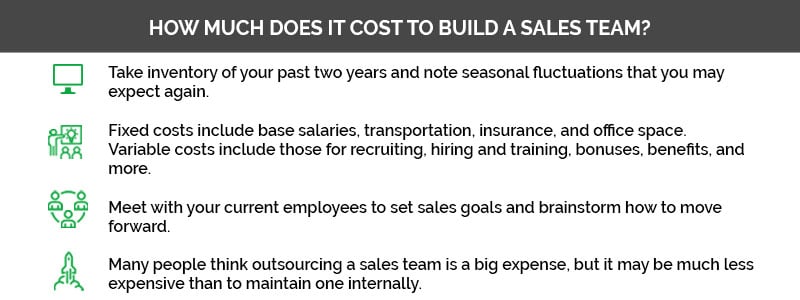How Much Does It Cost to Build a Sales Team?

Making the decision to go from founder-selling to a fully functional, self-sufficient sales team is a big step! Here are some rough guidelines for what you can expect to pay for training, salary, commission, and enablement tools.

Business growth also means increases in staffing. Being able to move away from founder-led selling means you’re at the point where you’re considering bringing on an internal sales staff. Congratulations!
This is a big decision, and cost is one of the biggest factors you’ll be considering when deciding whether it’s time to bring on a sales team. Monetary investment isn’t the only investment you should consider, though: You should also think about the necessary time investment.
Here’s a breakdown of what it actually takes to build your very own sales team and whether you should consider outsourcing yours.
Gather your baseline data
As you develop the budget for a fully functional sales team, take inventory of your numbers for at least the past two years you were engaged in founder-led selling. Organize the data to take note of busier times and any seasonal sales fluctuations or trends that may be expected each year.
Calculate the fixed and variable costs
You’ll need to figure out your fixed costs before you can complete an accurate sales budget. Fixed costs include base salaries, transportation, insurance, and office space. Fluid costs are those associated with products or services, recruiting, hiring and training, bonuses, benefits, and commissions. You can then add in variable costs – such as recruiting costs, training, and benefits – associated with your staff. This can give you a total picture of what you spend on business, which will help you set realistic sales goals.
Set sales goals from there
If you already have employees, meet with them to set sales goals and brainstorm how to move forward. The goal is to collaborate to find a path to reach your monetary goals. You may decide to focus on increasing the amount per sale, for example, so the sales team may need to upsell existing customers. If the goal becomes to increase sales, the sales team may then be given the task to generate new leads.
Have a dedicated sales enablement team
A dedicated sales enablement team will help your sales team facilitate the best strategies to achieve your desired growth. An enablement team is dedicated to helping reps and managers with technology, tools, content, and reports to increase capacity and efficiency. More than half (65%) of sales leaders who exceeded their revenue targets in 2020 had a dedicated sales enablement team. This is especially vital for a hybrid or remote operations. More than half of the companies that already utilized sales enablement teams increased their sales enablement budgets during the last year, for example.
Invest in training
There are very few people who can get a job done without the right tools or resources available – let alone be a top performer. One sales management training survey found that 41% of the companies that responded had allocated zero budget for sales manager training. The 59% that allocated theirs for general management, not for leading a sales team.
Training employees isn’t cheap, either. Employee turnover can cost 33% of an employee’s salary on average. LinkedIn’s 2019 Workforce Learning Report revealed that 94% of employees indicated they’d stay at their place of employment longer if provided learning opportunities, though. Training your employees and providing opportunities for development is thus a worthwhile investment. Your goal should be to equip your sales team as well as craft an environment conducive to top performers.
Professional development increases employee engagement, too: A survey of over 2,000 employees found that organizations that offer opportunities for professional development increase engagement by 15%. These businesses also saw a 34% higher retention rate when compared to those that don’t offer professional development opportunities.
The case for outsourcing vs. handling internally
Many people think outsourcing a sales team is a big expense, but it may be less expensive than maintaining one internally. Here are some things you’d need to consider to maintain a sales team:
- A sales enablement team
- A sales operation team
- A technology stack subscription and limits
- Insurance and retirement benefits
- Bonus and commission structures
- Supervision and management personnel
- Employee training
- Cost of recruitment efforts
- Employee turnover costs
Your starting salary would need to be around the average base, which is $46,010, to pay a competitive wage for salespeople. If this number is affordable, there are still reasons why outsourcing may still be the best decision for you and your business. The time involved may not be the best use of your time as a founder, for example. Sales is a field with notoriously high – and costly – turnover rates, and recruitment is time-consuming. Your time may be better spent on efforts to scale your business.
It may be much quicker and more affordable than you think to have a team of top performers selling for you. At MetaGrowth Ventures, we deliver massive growth with minimal investment so you can ditch the daily grind of “founder selling” by having a team of dedicated sales professionals do your selling for you. We help you find the right people, train them on the necessary skills, and track their progress so you can focus less on sales and more on the big picture.
If you want to build your very own world-class sales team without investing a ton of time, contact us today. We’ll help you build a dream team to start boosting your sales in no time!
Written by
Joe Arioto
